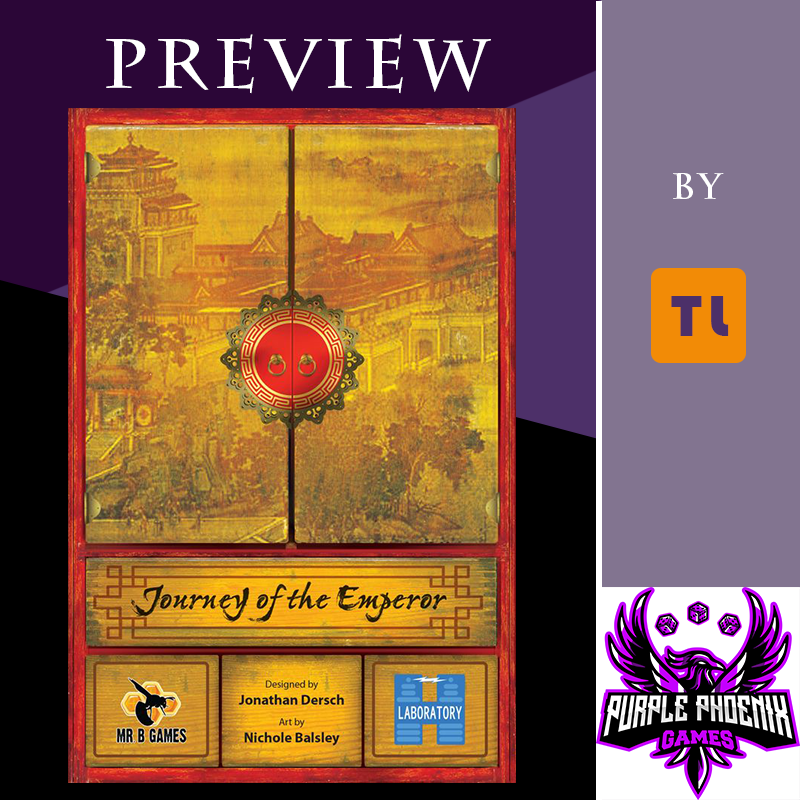
Do you think you know how to party? I thought I did, too. Then I played Journey of the Emperor, where you are planning an exciting party of journeys for the Emperor and their friends. They are all relying on YOU to provide them with the best journeys seeing exciting animals, beautiful flowers, and colorful lanterns along the way. But will you be able to plan wisely in the limited time you have been given? Let’s find out.
| Journey of the Emperor (2019) | Laboratory H |
| 2-5 Players | 30 minutes |
| Ages 10+ | BGG Weight – (not yet available) |
We were very excited to receive this game from Laboratory H for preview before they began their Kickstarter campaign. We love games with an Asian influence, and it seemed to have touches and inspirations from Tokaido, another favorite of ours. What we received is its own beast with great art and components.
So like I alluded to in my intro, you play a party planner drafting the best path cards to build the most killer journeys for your Emperor. You are dealt a hand of path cards – big, beautiful cards – that can feature different combinations of Journey Start, Journey End, animals, and lanterns icons. To assist you in focusing your strategy, you are also dealt four Emperor’s Favorites cards, from which you will keep two and discard the others. From the large stack of remaining path cards you reveal six as an offer and the game can begin.
On your turn you will be drafting cards from the offer, playing cards from your hand, and trying to complete objectives for points on your Emperor’s Favorites and Journey Start and End cards. These cards have scoring conditions printed on them to help tailor your play. So a Journey End card could have a picture of a flower on it (as all Start and End cards do) with a scoring condition of 3 points for every tiger icon on this completed Journey (I want to call this a “scoring panel” for this review to make it easier). So then you want to concentrate on getting as many tiger icons into this Journey to score tons of points. Or perhaps a Journey Start card will have a different flower, and state that you get 21 points for every set of tiger, dragon, and turtle icons. Either way, you now have a goal to achieve and you spend the game trying to amass the most points from these scoring opportunities and those found on your Emperor’s Favorites cards, which have similar scoring iconography. Most points at game end wins!
While this seems easy and that there is no inherent strategy, let me introduce the wrinkle. You can only score points from completed journeys. Each completed journey has at least a Journey Start and Journey End card. These cards will be adjacent to each other to form a pathway through the cards. You may never add a path card to your journey between two existing cards, but they can be added to the edges of a journey – either at the beginning or the end. If you add to the beginning, you will completely cover up the Journey Start card’s scoring panel so that you can create an uninterrupted path. Herein lies the strategy. At what point do you take the plunge and cover up a scoring panel to add to your journey? Yes, you can get way more points by doing this, but in a 4-player game you only have EIGHT turns. So do you feel like you will be able to draft just the right cards to maximize your scoring or will you falter and not be able to complete a journey in time, thus forfeiting any points you could have scored? Oh, you clever game…
Components. This is a smaller card game. The Emperor’s Favorites cards are about the mini size you would find in OG Ticket to Ride. The path cards are much larger and similar to the tarot sized cards, if not even taller. Both are of great quality with the wonderful linen finish (that I’m learning is more polarizing than I originally thought, but I love it!). Our review copy came with a few scoring sheets to tally the final scores – which we didn’t use correctly but still arrived at the correct final scores. The art in this game is truly breathtaking. The details in the murals in just the backgrounds of the path cards are amazing, and the flowers and animals are really really incredible. If we had one small gripe about the art, it was mentioned that someone could not tell much of a difference between the tiger and the dragon icons on the path cards. I didn’t have much of a problem deciphering the difference, but they are very similar in color and style, so I can see how others may view this as an issue for them.
DISCLAIMER: These are preview copy components, and I do not know if the final components will be similar or different, or if the Kickstarter campaign will alter or add anything through stretch goals.
That said, I am very satisfied with the components provided in this game.
This is a really good game. A lot more thinky than Tokaido (using a similar theme), and ultimately more enjoyable because you really feel you have control over your turns and aren’t just going for the best available at the time. You actually have to employ strategy here in order to be competitive. And although this is not a spiteful take-that game, you most certainly can foil your opponents’ plans indirectly by drafting their much-needed path cards. The art is amazing, the game is a great length, and you really want to keep playing. To me, that is the mark of a really good game. All that said, I would recommend this one if you are looking for a quick game that gives you all the good feelings of Tokaido but also scratches more of a gamer’s itch for actual strategy. Oh, and it’s absolutely beautiful.

